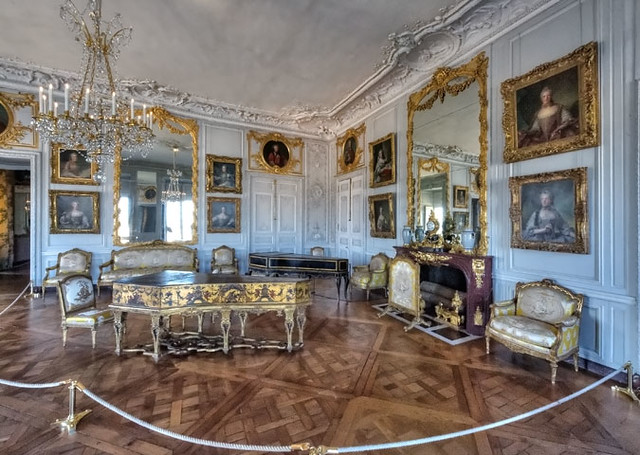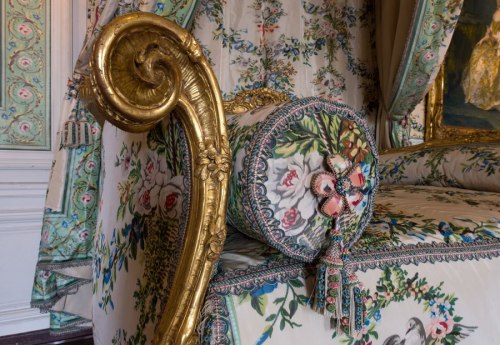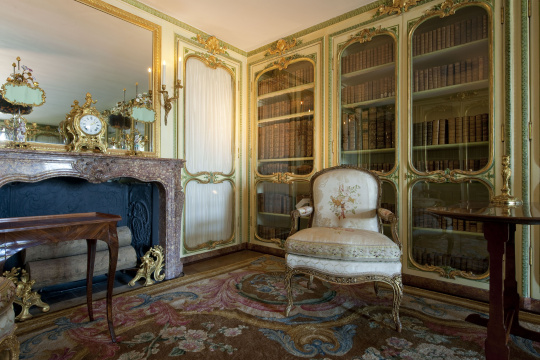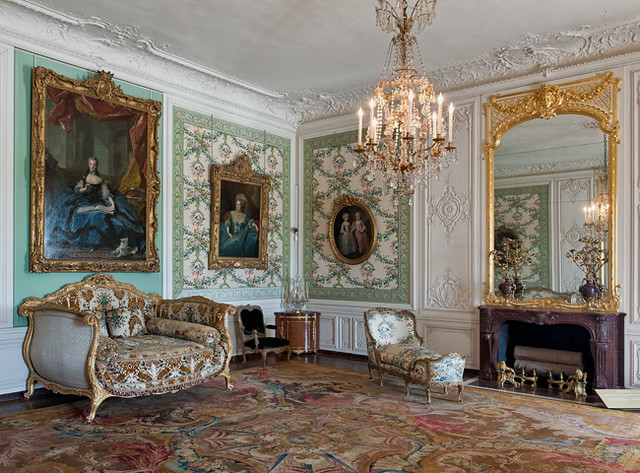1) First Antechamber
This was the first antechamber of Madame Victoire - the "leading lady" of the Mesdames Tantes. It formerly served as Louis XIV's bath chamber at which time the salon was covered in tiles and a large tub was placed at the centre of the room - the tub is now at the orangerie.
Madame Victoire was not the first of the Mesdames to inhabit this room. Madame Adelaïde had lived there from 1752-53 and Madame Sophie had also occupied the room from 1755-1767 - and then it was passed on to Madame Victoire.


2) Second Antechamber
Along with the First Antechamber of Madame Victoire this room was originally a bathroom of Louis XIV. The Sun King had chosen to use marble for the walls and floors (much like you see in bathrooms of today). One end of the salon was dominated by a couch placed inside a framed alcove. The window shutters are also from the time when the room functioned as a bathroom and they are decorated with dolphins.
After Louis XIV the room went into the possession of the Count de Toulouse and after him the Countess de Toulouse. But rooms at Versailles often changed hands and this particular salon soon became the home of Madame Adélaïde. Madame Victoire took over the room but at that time she lived with her two other sisters Sophie and Louise. The room finally became Madame Victoire's completely when it was made into a second antechamber in 1767 - that year the alcove was removed.
It is widely believed that the wood-works were carved for Madame Victoire herself. The paintings above the doors (by Oudry) were originally intended for the Dauphin but found their way into this salon instead; they depict the Fables of La Fontaine. A white marble bust of Marie Josephine Louise of Savoy is placed on the mantelpiece. A Riesener chest-drawer placed in this room has been transferred from the southern wing from the apartment of the Countess d'Artois. A large folding-screen has been placed in the corner and a clock in the "Chinese" style rounds up the inventory list of the second antechamber. The colour of the walls are white which is quite a rare sight at Versailles; normally a wall is either elaborately decorated or painted in a pale colour on carved wood-work.



3) Grand Cabinet

Louis XIV used this room as a part of his bathing rooms - it was known as the octagonal room. At that time it was renowned for the extreme wealth in marble, paintings and sculptures that had gone into this room but that changed when the room was handed over to the Mesdames Tantes in 1763. They thought that the marble décor was too old-fashioned and immediately had the room redone after the new fashions. The only remaining parts of the original room are the cornice, the beautiful fireplace and the decorations in the corners - everything else had undergone a monumental change.
There is one object in particular that remains as a testimony to Madame Victoire's passion for music: the harpsichord by Blanchet. Madame Victoire was regarded as one of the finest players of this instrument - a thought shared by people outside the French court. Mozart himself dedicated his first six pieces on the harpsichord to the Madame.






4) Bedchamber

This room has changed hands quite a lot of times. Its first owner was Louis XIV who used it as an antechamber to his bathroom(s) - it was called the ionic antechamber due to the twelve marble columns that made out the decoration. Then it changed to the hands of the Count de Toulouse and from him to the Countess de Toulouse. Madame Adélaïde took over next until the room was passed on to the youngest sister of the Mesdames, Madame Sophie. Madame Sophie was given this room in 1767 and used it as a bedroom. A year later it changed owner again and became the bedroom of Madame Victoire as we know it today.
Rousseau was given the task of cutting the wood-work of Madame Victoire's bedchamber. The dominant colour of the bedchamber is a soft green mixed with a white pattern. When Madame Victoire took over the room in 1769 two corner cupboards was delivered from Péridiez. They were sold during the revolution but returned to Versailles when they were bought back in 1982 from England (before that the cupboards had been located in Russia). The screen in front of the fire-screen was delivered to the bedroom of the Countess de Provence in 1787.
Quite a few of the occupants of the room has been portrayed in paintings that now adorn the walls:
A portrait of Madame Sophie hangs above the left entrance - the princess is wearing a pink gown. Marie-Josèphe of Saxony is portrayed in the large portrait to the left of the rear wall. The centre picture is of Madame Adélaïde and to her right is the Dauphin Louis (son of Louis XV).









5) Blue Cabinet
The interior cabinet of Madame Victoire (the room is also referred to as "Petit Cabinet Bleu") was originally a part of the Doric Hall which was a part of the bath apartments. The large hall (also consisting of the two rooms next to this) was converted in 1724 to two antechambers for the Comte and Comtesse de Toulouse. The Comtesse de Toulouse's antechamber was further divided in 1767 into two small chambers. From then on the two small cabinets would function as a living room and a library. Madame Victoire commissioned a chest of drawers in 1768 which is still placed in the cabinet; today her alabaster dish is placed upon it. Antoine Rousseau was responsible for the pretty white and pale-blue wood-work done to the walks and the fireplace was created by Serancolin - both were restored to partially their original state. The dominant writing desk was made for the Mesdames Tantes for their favourite place of Bellevue.
A portrait of Madame Victoire herself hangs in the chamber. A couple of chairs in the room was originally located in the salons of Madame d'Harcourt but they were moved to the eldest of the Mesdames Tantes' rooms in 1787. Another portrait hangs in the room and portrays Madame Adélaïde.




| Madame Victoire |
However, it is a certainty that the vermeil table was made for Madame Victoire - it has her coat of arms engraved in it. The chairs were delivered to Madame de Pompadour in between 1755-60 and was later used by Madame Victoire as a part of her furniture at Bellevue - they were created by Nicolas Quinibert Foliot. The desk was created for either Madame Sophie or Madame Louise in 1760 and was originally housed in the south wing of the château. The top of the cupboards are painted in a pale moss-green surrounding a golden medallion.
A painting of the Battle of Fontenoy is placed in one of the cupboards.





No comments:
Post a Comment